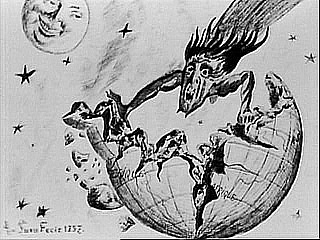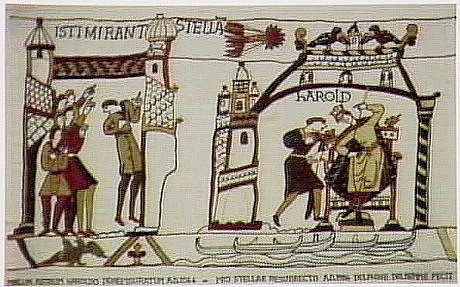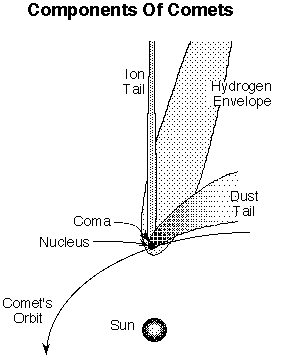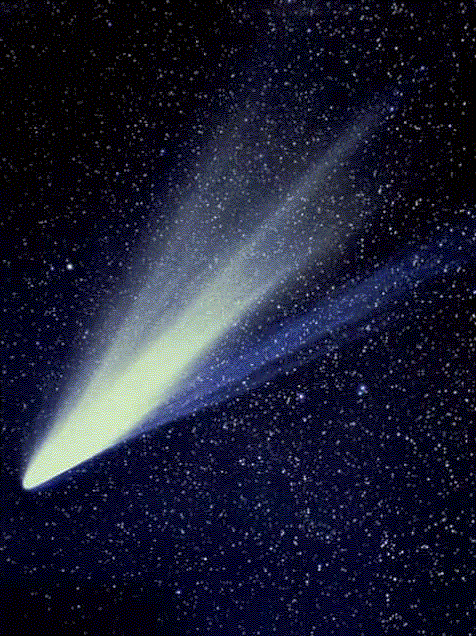 One view of comets as destroyers of worlds in 1857. (Original source unknown) |
 King Harold and nation cower in fear at the close passage of Halley's Comet (picture from part of the Bayeux Tapestry; more pictures at The Bayeux Tapestry Gallery). |
The passage of the comet Hale-Bopp through our part of the solar system created spectacular displays in the spring of 1997. Every newspaper, television and radio station carried some report with photos of the comet. We had a foretaste of the Hale-Bopp show when Comet Hyakutake passed close to the Earth in the spring of 1996. Hale-Bopp was one of the brightest comets to grace our skies this century, coming close to the displays put on by Comet West in 1976 and Halley's Comet in 1910. Many people were justifiably interested in Hale-Bopp---it was a gorgeous site! Many people also tuned into the news and astronomy web sites in the summer of 1994 when the comet Shoemaker-Levy 9 smashed into the planet Jupiter. Predictions of Jupiter's demise were, of course, greatly exaggerated---Jupiter took the hits in stride.
 One view of comets as destroyers of worlds in 1857. (Original source unknown) |
 King Harold and nation cower in fear at the close passage of Halley's Comet (picture from part of the Bayeux Tapestry; more pictures at The Bayeux Tapestry Gallery). |
Our favorable view of comets is a big change from the dread and fear people held of comets even less than a century ago. Comets were usually thought to be omens of bad events to occur on the Earth. King Harold of England took the passage of Halley's Comet to be a sign of his defeat in 1066. However, William the Conqueror took it as a good sign and led the Normans to victory over King Harold's army. As recently as 1910 people thought the end of the world was near when it was discovered the Earth would pass through the tail of Halley's Comet. Astronomers had discovered the presence of cyanogen molecules in the tail, so the popular media spread tales of cyanide poisoning of the Earth. Even with great effort the astronomers were not able to convince many people that we faced no danger---a comet's tail is extremely diffuse so the minute amounts making it through the atmosphere and being breathed by helpless human beings was much, much less than the noxious stuff they breathed everyday from industrial pollution. The tragedy of the Heaven's Gate cult shows that despite our current knowledge of comets, there are still those who view comets with great superstition or as something much more than the icy bodies they are from the outer limits of the solar system.
Comets are small "potato-shaped" objects a few hundred meters to about 20 kilometers across. They are made of dust grains embedded in frozen volatiles (materials that vaporize at low temperatures) like water, methane, ammonia, and carbon dioxide (they are like "icy dirtballs" ). They are primitive objects which means they are unchanged since they first solidified from the solar nebula about 4.6 billion years ago. Comets are frozen relics of the early solar system holding valuable information about the formation of the planets.

When a comet gets close enough to the Sun, it changes into something more spectacular. The picture above shows the parts of a comet that form when the cold "icy dirt ball" is warmed up by the Sun. This picture is courtesy of David Doody at JPL and is part of the Basics of Space Flight manual for all operations personnel. The comets that have exhausted their supply of ices from repeated passages near the Sun or the remaining ices become insulated enough by the dusty or rocky material to no longer vaporize are reclassified as asteroids. Some comet researchers even call the icy bodies in the Kuiper Belt and Oort Cloud (that never get near the Sun) asteroids because the ices do not vaporize. Therefore, the line between what is called a "comet" and what is an "asteroid" is a bit blurry.
When a comet nears the Sun around the Jupiter-Saturn distance, it warms up. The ices sublime---they change from solid to gas without going through a liquid phase (like the white mist coming from a block of frozen carbon dioxide, "dry ice"). Jets of material will shoot out from the nucleus. These jets can alter the comet's orbit (remember Newton's third law of motion?)
Since the orbit of Halley's Comet is known so well, spacecraft were sent to it when it passed through our part of the solar system in 1986. Here is a close-up of Halley's Comet. The spacecraft Giotto launched by the European Space Agency on July 2, 1985 reached Halley's Comet on March 13, 1986 and snapped this photo from 25,660 kilometers (15,950 miles) away. It got to within 596 kilometers (370 miles) of the nucleus, passing by at 68 kilometers/second. The nucleus of Halley's Comet has dimensions of 8×8×16 kilometers. The nucleus has a density of only 0.1 to 0.25 times the density of water and is very dark---it reflects only 4% of the sunlight (coal reflects about 6%). The density is about that of a loosely-compacted snowball and it is quite fragile---you could break a piece of the nucleus in two with your bare hands!

Selecting the picture will take you to the Max Planck Institut für Aeronomie from where this image of Halley's nucleus came (will display in another window). The bright white jets on the left side of the nucleus are pointed in the direction of the Sun. Comet Hale-Bopp's nucleus is larger than Halley's nucleus---10 to 40 kilometers in size (about twice the size of Halley's Comet's nucleus) and is dust-rich. It began ejecting material when still at the distance of the outer planets, so it was discovered while still a couple of years from its perihelion passage in March of 1997. Comet Hyakutake (bright comet of spring 1996 that passed within 0.1 A.U. of the Earth) has a nucleus 1 to 3 kilometers in size. Five other comet nuclei that have been imaged up close by spacecraft are shown below: Comet Borrelly (about 8 km long) on the top left, Comet Wild (about 5 km in diameter) on the top right, Comet Tempel 1 (about 7.6 km x 4.9 km) before it got hit by the Deep Impact probe in July 2005 and Comet Hartley 2 (about 2.0 km x 0.8 km) on the bottom left and Comet 67P/Churyumov-Gerasimenko (about 5 km x 3 km) on the bottom right. Like Halley, they too are very dark.
Churyumov-Gerasimenko image links: mid-March 2015 and mid-November 2014. |
The Deep Impact mission was designed to investigate the interior of a comet by crashing a 370-kg copper impactor into the nucleus of Tempel 1 and analyzing the material shot out from the impact (copper is an element not expected to be in comets). Tempel 1 is made of a mixture of materials with high and low melting temperatures which tells us that the early solar nebula was more complex than previously thought. It has silicates like beach sand with olivine and pyroxene that would have come from the inner solar system, carbonates and sulfide that would have come from part of the solar system farther out, and ice (mostly water ice and a little carbon dioxide) from the outer solar system. Tempel 1 has a powdery surface layer a few tens of meters thick with most of the ices missing in that surface layer ("a marshmallow dipped in powered sugar"). There are a few smooth patches of water ice on the surface. Young surfaces right next to old, battered areas with a layered (slabs of ice) interior filled with pockets of empty space tell us the geological history of comets is more complex (and interesting!) than we initially thought.
The Deep Impact spacecraft was renamed the EPOXI mission. It flew by comet Hartley 2 on November 4, 2010. Hartley 2 is about a quarter the size of Tempel 1. Its two ends are rough and knobbly from which spew jets of carbon dioxide ("dry ice") and a smooth region between the two ends from which frozen water sublimates through the dust. The images were clear enough that astronomers could see jets spewing out from specific surface features and even the "snow" particles in the jets the size of golf balls to basketballs. This is the first comet for which frozen carbon dioxide has provided the jets---usually the jets are made from the sublimation of frozen water. Select the images to go to the websites from where these images came (both images courtesy of NASA/JPL/UMD).
The Rosetta mission of ESA was the first mission to orbit a comet, land on its surface, and study a comet up close through its various stages of activity as the comet approaches the Sun. Rosetta rendezvoused with Comet 67P/Churyumov-Gerasinmenko in August 2014 after more than a decade's journey. Along the way to Comet 67P/Churyumov-Gerasimenko, Rosetta flew by Asteroid Steins in September 2008 and Asteroid Lutetia in July 2010. The mission consisted of two spacecraft: the Rosetta Orbiter and Philae Lander. Rosetta began orbiting the comet in early September 2014 while the comet was about 3.5 AU from the Sun, between the orbits of Mars and Jupiter. The comet nucleus looks like two round pieces stuck together with a narrow bridge of ice-rock material, so it is technically known as a "contact binary". The nucleus is about 2.2 by 2.6 miles in dimension and is darker than charcoal, so the images you see on the web have been light stretched in order to see the details. There is a mix of craters and smooth areas on the surface like that found on Comet Tempel 1. The smooth areas are dusty---probably the result of material deposited from outgassing and several of the craters, at least, are vents from which the ice-dust material comes. Other craters are the result of impacts.
The Philae Lander touched down on the surface in November 2014. The lander had a mass of about 100 kilograms but because of the comet's very weak gravity, the gravity force the lander felt on the comet's surface was only about the weight of a piece of paper on the Earth's surface. Therefore, the lander was fitted with a combination of ice screws on its feet and harpoons to secure itself to the surface. However, the landing equipment did not work properly, so it bounced twice and settled against a cliff wall at such an angle that it could not recharge its batteries with its solar panels. Before it went into hibernation, it did manage to make several measurements with its suite of scientific instruments. When the comet got to about Mars' distance from the Sun in June 2015, the lander awoke to resume some investigation of the comet's surface but communication with the Rosetta orbiter was hampered by the increasing activity of the comet. The Rosetta had to remain at a safe distance from the comet due to the very dusty environment of the coma.
Each of the Rosetta mission spacecraft had a whole suite of instruments on board to explore this relic from the solar system's formation 4.6 billion years ago. The Rosetta Orbiter was powered by a huge set of solar panels that span 32 meters, the largest of any interplanetary craft. The name "Rosetta" was chosen because we hope that this mission will be the Rosetta Stone of finally understanding the language of comets. We will better understand the connection between the local features of the interior and surface of the ice-rock nucleus and the environment of the comet's coma and the tail. With that knowledge, we will be able to understand what our past observations of comets from the Earth and brief flyby missions have tried to reveal to us. Some early results from the Rosetta mission include: that a number of the dust jets from the comet can be traced back to active pits that probably form when volatiles under the surface escape into space and the surface material collapses as a sinkhole; extensive layering seems to show that the material accumulated over a lengthy period; the high porosity, low density, and weak strength of the nucleus and dust in the coma show the comet formed from low-speed accretion of material to make a fluffy aggregation of dust particles over an extended period of time in the earliest stages of the solar system's formation; and the double-lobed shape of the comet plays an important role in the cycle of activity of different parts of the comet and how dust is transported among parts of the comet in different parts in its 6.5-year orbit around the Sun.
The Rosetta Orbiter orbited the comet for a two-year period of time that included the perihelion passage on August 13, 2015, so Rosetta explored the various stages of a comet's activity up close. On September 30, 2016, the orbiter became a lander, ending the mission by landing on Churyumov-Gerasinmenko in a region with several active pits. Discoveries will continue to made for many years to come as we continue to analyze the enormous amount of data gathered by Rosetta. The image below compares the sizes of all six of the comet nuclei that have been visited by spacecraft (as of 2018) with addition of Churyumov-Gerasinmenko to the original image. A beautiful video of some of the most scenic images of Churyumov-Gerasinmenko is posted on Vimeo. The European Space Agency created a series of cartoons of the Rosetta mission that highlight the key findings from the mission.
Gas and dust pouring out from the nucleus forms a huge atmosphere around the nucleus. This is the bright core, called a coma, you can see when you observe a comet from the Earth. It is 100,000's of kilometers across. Because the nucleus has such low gravity (you could jump off it!), it cannot hang onto the escaping dust and gas. NASA's StarDust mission captured material from Comet Wild 2's coma in early January 2004 and returned the microscopic dust grains embedded in aerogel to Earth in mid-January 2006. It found that Comet Wild 2, like Comet Tempel 1, is also made of a mixture of materials with high and low melting temperatures. This may be the result of material originally forming near the Sun that got ejected to the outer parts of the solar system nebula via the bipolar jets we see in many young, forming stars. Further analysis of the Comet Wild 2 material has uncovered Glycine, an amino acid. Rosetta also found Glycine in Churyumov-Gerasimenko's coma.
Almost a year after the EPOXI spacecraft flew by Hartley 2, astronomers using the infrared Herschel Space Observatory were able to measure in the infrared band the ratios of regular water to "heavy water" in the comet's coma. Heavy water has one of the normal hydrogen atoms replaced by its heavier isotope cousin, deuterium. The ratio between heavy water and regular water from Hartley 2 matches the ratio of Earth's ocean water. Another team using the Stratospheric Observatory for Infrared Astronomy ("SOFIA", a converted 747 that flies a 2.7-meter infrared telescope into the stratosphere) measured the water isotopes in Comet Wirtanen in December 2018 and found its water matches Earth's ocean water also. The other ten comets that have measured regular water to heavy water ratios (including Hyakutake, Hale-Bopp, Halley, and Churyumov-Gerasimenko) are relatively enriched in heavy water---their heavy water to regular water ratios are two to three times as great as the Earth's ocean water. Eight of the other comets come from the very distant reaches of our solar system, called the Oort Cloud discussed in the next section, while Hartley 2, originally came from a closer region just outside of Neptune's orbit called the Kuiper Belt (also discussed in the next section). Perhaps comets from the Kuiper Belt supplied some of the water found on the terrestrial planets. What is surprising about Hartley 2's water is that the Kuiper Belt comets were expected to have an even higher percentage of heavy water than the Oort Cloud comets. Further uncertainty about the process resulted when the Rosetta mission found that Comet 67P/Churyumov-Gerasimenko could not have supplied the Earth with its water despite the fact that Churyumov-Gerasimenko is probably originally from the Kuiper Belt like Hartley 2. The range of deuterium-to-hydrogen ratios from the various comets studied indicates that comets formed over a wide range of distances from the Sun. Molecular oxygen and nitrogen being outgassed along with the water vapor from Churyumov-Gerasimenko tell us that the comet formed in a very cold region of the solar nebula.

The Sun is constantly spewing out charged particles, called the solar wind, into the solar system. The solar wind travels along solar magnetic field lines extending radially outward from the Sun. Ultraviolet light from the Sun ionizes some of the gases in the coma. These charged particles (ions) are forced along magnetic field lines to form the ion tail millions of kilometers long. The blue ion tail acts like a "solar" wind sock. The ion tail always points directly away from the Sun, so when the comet is moving away from the Sun, its ion tail will be almost in front of it! The blue color is mostly from the light emitted by carbon monoxide ions but other types of ions also contribute to the light. Since the gas is so diffuse, the observed spectrum is an emission-line spectrum.
The dust tails forms from the solar photons colliding with the dust in the coma. The dust forms a long, curved tail that lies slightly farther our from the Sun than the nucleus' orbit. The dust tail has a yellow-white color from reflected sunlight. Both of the tails will stretch for millions of kilometers. Because of the large amount of dust, Hale-Bopp's tail was much brighter and whitish-yellow from reflected sunlight. Hyakutake's tail was dimmer and blue-green in appearance because of the low amount of dust and proportionally more ions.

Comet Hale-Bopp was a spectacular comet in the spring 1997 sky. Courtesy of Darren Bly
![]() Go back to previous section --
Go back to previous section --
![]() Go to next section
Go to next section
last updated: November 15, 2023